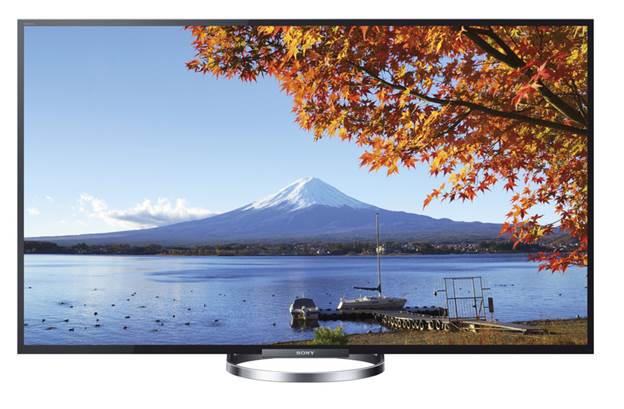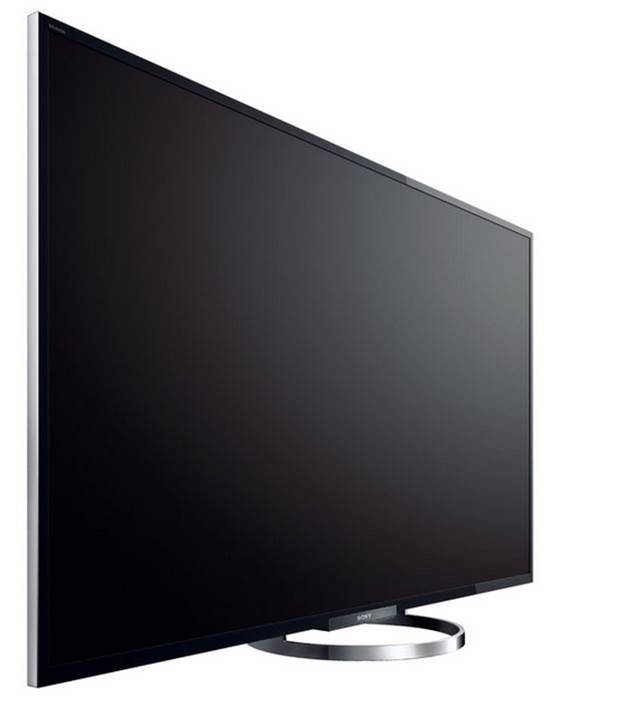With all the ink spilled these days about
the trendy but expensive Ultra HDTVs, a plain vanilla HDTV, with its resolution
of 1920 x 1080, may seem a lile ho-hum. But Ultra HD (4K, or more correctly,
3840 x 2160) is still consumer 4K content-starved with its specs not yet fully
complete, and the jury is still out as to whether or not it will offer
significant benefits in typical home screen sizes. Its price of admission also
remains high. As a result, top-of-the-line, non-Ultra HDTVs, such as Sony’s new
KDL-65W850A, remain serious players in the high-end video market.
Description
I’m accustomed to 65-inch sets by now, but
if you’re not, the KDL-65W850A will look huge in most domestic spaces. Be not
afraid. First of all, it’s thin – though at just over 2.5 inches, not the
thinnest of flat screens. Second, at under 80 pounds, even on its non-rotatable
stand, it isn’t that difficult for two people to unpack and set up.

The
65-inch Sony weighs under 80 pounds
Compared with thinner designs, the Sony’s
2.5-inch depth offers more room behind the LCD panel to provide for a
relatively uniform diffusion of the LED edge lighting uniformly across the
screen (while the edge lighting here incorporates local dimming, this is not a
back-lit design with multiple, individually dimmable zones behind the screen).
While that uniformity isn’t perfect here, the deviations are subtle and visible
mainly on test patterns. They never bothered me on real program material.
The screen’s surface is also less glossy
than usual. It’s far from having a totally mae finish; you’ll still see
reflections from the screen in a lighted room. But they’re soft and furry
compared with the mirror-like images that stare back at you from most of
today’s sets.
The Sony follows the current trend of
providing more than enough video controls to either optimize the picture or
thoroughly mess it up. But not to worry; you can’t damage anything with the
user controls, and they’re easy to reset. The one significant omission here is
a color management system (CMS) for fine-tuning the color gamut. Sony doesn’t
typically offer this feature on its flat-screen sets, though much of its
competition now does. But as with most recent Sony’s we’ve tested, the
out-of-the-box color gamut is more than satisfactory, though not quite
technically ideal.

The
Sony is a thin but not too thin 2.5 inches deep
The KDL-65W850A offers the usual
bewildering range of picture modes – 14 to be exact. But the specific subset of
Picture Modes you can choose from depends on which Scene Select option you
select. To keep from going postal with the bewildering range of Scene
Select/Picture Mode combinations available, I chose Scene Select-Cinema (and
the Cinema 2 Picture Mode) for 2D and Scene Select-General (and the Standard
Picture Mode) for 3D. This approach did require me to manually change the Scene
Select mode when-ever I went from 2D to 3D – If you use different Scene Select
settings for 2D and 3D, the set will not automatically change Scene Select
modes when you swap 2D and 3D sources. This can be avoided by staying in the
same Scene Select and Picture Mode throughout, but the General/Standard
combination offered more brightness in 3D than any Cinema mode, and without
significant (post-calibration) tradeoffs.

The
65-inch Sony has a non-rotating stand
Motionflow engages Sony’s frame
interpolation (or dark frame insertion in some settings) to smooth out motion
blur. Without it, I did see some blur on fast motion – but no worse than usual
for an LCD set. It was tolerable, and in my opinion, preferable to the
video-like, soap-opera look common to motion interpolation. I left Motionflow
off for all my tests and viewing.
As noted, the KDL-65W850A uses edge-lit
local dimming, and it boasts Sony’s Triluminos color technology, said to extend
the color palette. However, without elaborating, Sony clarified that this
version does not use the Quantum Dot technology employed for Triluminos in the
model KDL-55W900A we reviewed for the July/August 2013 Home Theater (available
at soundandvision.com).The KDL-65W850A can also access and use the additional
color information (x.v.Color, AKA xvYCC) included on Sony’s “Mastered in 4K”
Blu-ray Discs.
The KDL-55W900A offers a wide range of
Internet features and apps, though the Web interface screen is less flashy than
much of its competition. But everything you might want is likely there. You can
also download firmware updates for the set and play back videos, photos, or
music either directly from a USB storage device or from your home network.
2D Performance
Our KDL-65W850A arrived in a substantial
wood crate, which suggested that this was a dedicated review sample and likely
from an early production run. Expect yours to come in the standard cardboard
carton.
The set performed exceptionally well on
good sources. Its color was visibly flawless, with clear, natural flesh tones
and crisp but not overstated resolution. One of the video controls, SBM (the
acronym for Sony’s Super Bit Mapping) is on by default. After trying it both on
and off, I left it on. It appeared to do no harm, though I can’t say it
provided any tangible benefit. (Sony responded latter our review was complete
that SBM tends to be more noticeable on specific types of program material,
such as sunsets and other more depth-related content.)